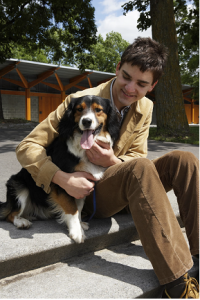 Dogs have proven themselves to be vastly valuable to humans in many capacities, including work and companionship. The definition of “companion dog” tends to be rather wide and nonspecific, as it means different things to different people. Although dogs have fulfilled the role of worker and helper for people for many generations, they are also valued for the pleasure of their company and companionship only. We all know about the unconditional love that dogs can bring to their owners and families.
Dogs have proven themselves to be vastly valuable to humans in many capacities, including work and companionship. The definition of “companion dog” tends to be rather wide and nonspecific, as it means different things to different people. Although dogs have fulfilled the role of worker and helper for people for many generations, they are also valued for the pleasure of their company and companionship only. We all know about the unconditional love that dogs can bring to their owners and families.
In the past, many breeds of dogs were raised primarily to work, and were bred to do jobs like sled pulling, rescue work and guarding. Great Danes, Mastiffs and Doberman Pinschers are examples. Although these work breeds sometimes continue to function in the same ways, newer work roles in our society have emerged, including ADA service dogs that are specially trained and licensed to help their owners. ADA dogs fulfill helper roles for many areas of disability, including blindness (Seeing Eye dogs), physical disabilities (mobility dogs) and hearing impairment.
In contrast, pets who are adopted primarily for companionship have no special training or abilities, and tend to be breeds that are easy to take care of and that get along with children and other pets. They are usually inexpensive and there are always more than plenty to choose from at any local shelter or pound. Although we usually think of these dogs as companion animals, terminology can be confusing, as the term is also used to describe the role of the ADA service dog by some.
If you are a member of the larger group of dog owners, the companion pet owner, there are some basics of companion dog training that we will describe for you. Owning a companion pet is a much more relaxed situation than dealing with a work or service dog, but without some basic dog training, your pet is likely to demonstrate behavior problems that are annoying and frustrating. The ability to follow basic commands to allow you to be able to control your dog as well as being house broken are essential. Companion dog training does not have to be time consuming or difficult as long as these basic suggestions are followed:
#1 Use positive reinforcement
Research indicates that using positive reinforcement is usually the most effective way to teach your dog new behaviors. Essentially, you reward your dog with something he wants AFTER he does what you want him to do. Click here to read more about positive reinforcement. Train before your dog eats a meal, as the rewards will be more reinforcing for him.
#2 Train for short periods of time
Your dog will love training with you (if you use positive reinforcement), but keep training sessions short, no more than 30 minutes, as your dog will lose interest in the activity and the reinforcement. Actually, training in two 15 minute sessions is preferable.
#3 Be consistent!
This is critical to your dog training success. Always use the same, simple command for your dog. Reward him immediately and train at the same time each day. Always make sure that everyone in the family understands and uses the same commands consistently. Giving your dog different commands will confuse him and set back your training significantly.
#4 Use short commands.
Most people tend to speak to their dogs as if they are people, talking in long sentences and making conversation. But this does not work well when you are trying to train your dog. Keep your commands short and easy to identify: sit, stay, come, heel, potty.
#5 Use hand signals
Hand signals are easier for some dogs to learn, and they have the added benefit of allowing you to control your dog’s behavior when he is too far away to hear a command.
#6 End your sessions positively
At the end of your training period, make sure to give your dog an opportunity to follow a simple command that he already knows, thereby ending the session in a frustration free, positive way.
And lastly, always be as patient as possible. Remember that your dog wants to please you and is not doing what he’s doing to upset you or make you angry. He probably doesn’t understand what he’s doing wrong or exactly what you want. Training takes time and requires much patience, but it will be rewarded if you follow these basic rules for your companion dog training.





